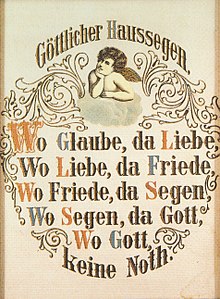House blessing

House blessings are in Christian folk tradition blessings for the home that are installed in the house. They are to place the house, all property and residents under the protection of God.
History and variants
The house blessings, which were widespread before the 19th century, were intended to protect the house and its inhabitants and to exhort to fear God. They were originally either applied directly to the wall or carved into the framework. Later, boards with slogans - mostly surrounded by a decorative ornament or set in a picture motif - that were hung on the wall came up. Together with (other) wall slogans , house blessings were sold as a mass product in the second half of the 19th century, due to the progress of the printing industry. They reached their greatest popularity around 1900.
Manufacturer or publisher are only given for larger and more splendid prints, but house blessings were probably printed by the large wall decoration manufacturers. The manufacturers included publishers such as Ernst Kaufmann in Lahr, Carl Hirsch or Morstatt Schrodt & Co. or its successor company Johannes Schrodt. An assignment to the individual prints is only possible in isolated cases.
One group of the prints is entitled Domestic Virtues and bears the verses "The house is ornamentation cleanliness, the house honor hospitality, the house blessing piety, the house happiness satisfaction". Specimens of this type from around 1860–70 have been preserved. They often hung next to a counterpart with the title Christian House Blessing or Divine House Blessing and the text "Where Faith, There Love ...". On some house blessings, the blessing is surrounded by a flower garland, which is held together by two angels at the top. The same image motifs could also be supplied with different texts (or vice versa).
Since house blessings were popular with both major denominations , the manufacturer was able to respond to the wishes of its customers: Images of Mary or saints were inserted for Catholics , images of Christ or crosses for Protestants , and sometimes a portrait of Martin Luther .
From the 1880s onwards, embroidered house blessings were widespread. They were then often decorated with small-format chromolithographs , so-called scraps (also called chromos or wafers) or with dried edelweiss flowers and ferns. They were also often combined with églomisés , a back glass technique. Some of these works are large-format, complex and have several blessings. Embroidered house blessings were a popular wedding gift and were not tied to any social class.
At the beginning of the 20th century, house blessings began to gain acceptance in rural areas and workers' housing, while they met with increasing rejection in the middle class and the petty bourgeoisie.
Carved house blessing
House blessings made of wood are a special kind - not as a message board, but as a three-dimensional cross. This shape emerged from the table cross that every farmhouse room had. This was burned annually at Christmas or Easter and newly carved by the foreman . In western Styria in particular , this resulted in the house blessing that was hung on the ceiling. This consists of a basic structure in the form of a double cross (axes of a double square pyramid with arcs of willow or hazelnut around). The arches are adorned with fan-shaped ornaments, and the Holy Spirit often hangs below as a dove. These carvings are best done with poplar wood .
Figurative meanings
The idiom of house blessings hangs crookedly expresses that there are temporary disagreements or arguments in a marriage or family.
See also
literature
- Wolfgang Brückner : Evangelical house blessings. In Andrea Thurnwald (ed.): A church becomes a museum. Workshop reports from the Museum Church in Franconia (= publications and catalogs of the Franconian Open Air Museum of the Middle Franconia district. Vol. 48). Verlag Fränkisches Freilandmuseum, Bad Windsheim 2006, ISBN 3-926834-64-1 , pp. 184-189.
- Wolfgang Brückner: House blessing. In Herbert May, Kilian Kreilinger (Ed.): Everything under one roof. Houses, people, things. Festschrift for Konrad Bedal on the occasion of his 60th birthday (= sources and materials for house research in Bavaria. 12). Imhof, Petersberg 2004, ISBN 3-86568-007-0 , pp. 381-401.
- Roland Halbritter: Paper canvas - from universal handicraft material to popular wall decorations. In: The Sciliar . Vol. 77, No. 11/12, 2003, pp. 80-101.
- Holger Heine: Sayings as wall decorations. In Ulrike Lange: Faith at home, as a reminder. Evidence of evangelical piety. Room monuments in the curriculum vitae. Arbeitsgemeinschaft Friedhof und Denkmal, Kassel 1994, ISBN 3-924447-09-8 , pp. 54–59.
- Bruno Langner: Evangelical world of images. Print between 1850 and 1950 (= publications and catalogs of the Franconian Open Air Museum of the District of Middle Franconia. Volume 16 = Hohenloher Open Air Museum. Catalogs and accompanying books. Volume 9). Verlag Fränkisches Freilandmuseum et al., Bad Windsheim et al. 1992, ISBN 3-926834-22-6 , pp. 95-107.
- Christa Pieske : Embroidered house blessings and their manufacturers. In: Rheinisch-Westfälische Zeitschrift für Volkskunde . Vol. 29, 1984, pp. 107-128.
- Christa Pieske: House blessing, embroidered on paper canvas. In: Christa Pieske: The ABC of luxury paper. Manufacture, processing and use 1860–1930. Reimer, Berlin 1984, ISBN 3-496-01023-1 , pp. 147-148.
- Christa Pieske: Wall slogans. In Christa Pieske: The ABC of luxury paper. Manufacture, processing and use 1860–1930. Reimer, Berlin 1984, ISBN 3-496-01023-1 , pp. 280-282.
Web links
Individual evidence
- ↑ So that the house blessing doesn't hang crooked , My District on March 10, 2016

